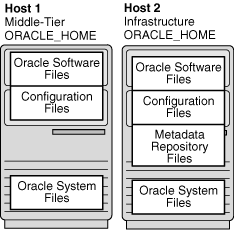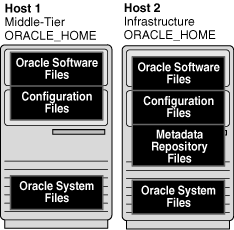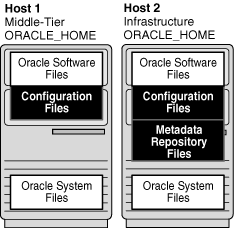|
Oracle® Application Server Administrator's Guide
10g Release 2 (10.1.2) B13995-06 |
|
 Previous |
 Next |
|
Oracle® Application Server Administrator's Guide
10g Release 2 (10.1.2) B13995-06 |
|
 Previous |
 Next |
This chapter provides information on getting started with Oracle Application Server backup and recovery.
It contains the following topics:
This section introduces the philosophy for backing up and recovering your Oracle Application Server environment. An Oracle Application Server environment can consist of different components and configurations. To determine which components and configurations best meet your requirements, refer to the Oracle Application Server Installation Guide and Oracle Application Server Concepts.
A typical Oracle Application Server environment contains:
An Infrastructure installation that contains Identity Management and a Metadata Repository
One or more middle-tier installations (J2EE and Web Cache, Portal and Wireless, or Business Intelligence and Forms) that may use the Infrastructure
The installations in an Oracle Application Server environment are interdependent in that they contain configuration information, applications, and data that are kept in sync. For example, when you perform a configuration change, you might update configuration files in the middle-tier installation and Infrastructure; when you deploy an application, you might deploy it to all middle-tier installations; and when you perform an administrative change on a middle-tier installation, you might update data in the Metadata Repository.
It is, therefore, important to consider your entire Oracle Application Server environment when performing backup and recovery. For example, you should not back up your middle-tier installation on Monday and your Infrastructure on Tuesday. If you lose files in your middle-tier installation, you could restore it to Monday's state. However, your Infrastructure would be in its current state—out of sync with the middle tier. And, because you backed up the Infrastructure on Tuesday, you would have no means of restoring it to a state in sync with Monday's middle-tier installation. You would not be able to restore your environment to a consistent state.
Instead, you should back up your entire Oracle Application Server environment at once. Then, if a loss occurs, you can restore your entire environment to a consistent state.
For the purposes of backup and recovery, you can divide your Oracle Application Server environment into different types of files, as shown in Figure 19-1.
Figure 19-1 Types of Files for Oracle Application Server Backup and Recovery

The types of files for backup and recovery are:
Oracle software files
These are static files such as binaries and libraries. They reside in the middle-tier and Infrastructure Oracle homes. They are created at installation time.
Configuration files
These files contain configuration information and deployed applications. They reside in the middle-tier and Infrastructure Oracle homes. They are created at installation or runtime and are updated during the normal operation of your application server.
There are two types of configuration files: configuration files managed by Distributed Configuration Management (DCM) and configuration files not managed by DCM. The files managed by DCM contain configuration information for OHS, OC4J, OPMN, Logloader, and JAZN. Components not managed by DCM include Portal and Wireless. The Backup and Recovery Tool creates an archive for each group of these components. The archives are stored in the same directory. In order to maintain synchronicity, the configuration files archive and the DCM-managed configuration files archive are paired by a unique timestamp. During restores, you specify the timestamp and the tool uses the timestamp to identify and restore both archives.
Metadata Repository files
These are the datafiles and control files that make up your Metadata Repository. They reside in the Infrastructure Oracle home. They are created at installation time and are updated during the normal operation of your application server.
Oracle system files
These files may be in the /var/opt/oracle or /etc directory, and the oraInventory directory. They exist on each host in your Oracle Application Server environment. They usually reside outside of your Oracle Application Server installations, although the oraInventory directory may be in an Oracle home. They are created and updated by Oracle Universal Installer at installation time and contain information about your installations. On Windows, some registries are created by the installer.
The strategies and procedures in this book involve backing up and recovering these different types of files in a manner that maintains your Oracle Application Server environment in a consistent state.
|
Note: Your Oracle Application Server environment contains additional files to those mentioned in this section, such as log files; database configuration files, includingorapwd, and spfile/pfile; and additional files you may deploy in the Oracle home, such as static HTML files and CGI scripts. You can add any of these files to the backup list.
|
This section describes the backup strategy used in this book. It contains the following topics:
The Oracle Application Server backup strategy involves two types of backups:
Image Backup
An image backup of an Oracle Application Server instance includes the Oracle Home directory of that instance, the OraInventory directory, the oratab file, and Windows registries on that node and finally a cold instance backup of that Oracle Application Server instance. The Oracle Home directory contains all the binary files, executables, initialization files, configuration files, log files, and so forth of the OracleAS instance and of all components and deployed applications in that instance. The OraInventory directory contains the installation information for the instance.
In Figure 19-2, the files that are backed up during an image backup of an Oracle Application Server environment are shaded. An image backup includes everything necessary to restore the initial installation of your Oracle Application Server environment including the Metadata Repository if the instance is an Infrastructure. To avoid an inconsistent backup, do not make any configuration changes until the backup is completed for all Oracle Application Server instances.
Figure 19-2 Files Backed Up in an Image Backup of an Oracle Application Server Environment

Instance Backup
The contents of an Instance Backup depends on the type of Oracle Application Server instance that is being backed up. There are three types of instance backups:
Oracle Application Server Infrastructure Instance Backup—The Backup and Recovery Tool first backs up the entire Oracle Metadata Repository database. The database contains the product metadata schemas for Oracle Application Server mid-tier components such as Portal and Wireless. If Identity Management is also installed in this instance, then the database may also contain the configuration information of the Oracle Internet Directory (OID) and Oracle Application Server Single Sign-On (SSO) components of the Identity Management Service. Next, the tool requests Distributed Configuration Management (DCM) to create and export a consistent archive (jar file) of the configuration schemas from the DCM repository for DCM-managed components like Oracle HTTP Server (OHS) and OracleAS Containers for J2EE (OC4J). Then, the tool adds the archive file to the backup. Finally, for each configured component, the tool backs up all the local copies of the configuration files specified for that component in its backup input file. For a list of component backup files, see Table 19-1, "Oracle Application Server Component Backup Input Files".
Oracle Application Server Middle-tier Instance Backup—Contains the configuration information of all its Oracle Application Server components and deployed applications. Some of these components, like Portal, Wireless, Integration B2B, and Oracle Business Intelligence Discoverer are not managed by DCM. They have their product metadata in the Oracle Application Server Metadata Repository database which is backed up by the Backup and Recovery Tool in the Oracle Application Server Infrastructure instance. Other components like the OHS, OC4J, Oracle Process Management and Notification Server (OPMN) and Java Authentication and Authorization Service (JAZN) are managed by DCM. The configuration information, for these components and the deployed J2EE applications, is stored in the DCM repository which can be a file-based repository or a database repository. As in an Infrastructure instance backup, the tool requests DCM to create and export a consistent archive of the configuration schemas from the DCM repository and adds the archive to the mid-tier instance backup. The tool also backs up all the local copies of the configuration files specified for each configured mid-tier component in its backup input file.
Oracle Application Server Metadata Repository Creation Assistant—Instead of creating a new Oracle Application Server Infrastructure instance, you can install the Oracle Application Server Metadata Repository in an existing Oracle database using the OracleAS Metadata Repository Creation Assistant (MRCA, previously called RepCA). The existing database may also have Oracle Internet Directory and SSO installed for Identity Management. Since there are no other OracleAS components in an OracleAS MRCA instance, the Backup and Recovery Tool backs up only the existing database and not any other local configuration files.
In Figure 19-3, the files that are backed up during an instance backup are shaded. This type of backup involves saving the configuration information, and metadata across your entire Oracle Application Server environment at the same point in time. To avoid an inconsistent backup, do not make any configuration changes until the backup completes for all Oracle Application Server instances.
Figure 19-3 Files Backed Up in an Instance Backup

Each Oracle Application Server component has a backup input file which contains a list of all the local configuration files that should be backed up for that component. In a backup operation, if a component is installed and configured, the Backup and Recovery Tool invokes the component's backup input file to determine what files to backup. A component backup input file has the file extension .inp and resides in the Oracle_Home/backup_restore/config directory. The following is a list of all the component backup input files that can reside in the directory:
Table 19-1 Oracle Application Server Component Backup Input Files
| Component Name | Backup Input File |
|---|---|
|
Content Management SDK |
config_cmsdk_files.inp |
|
Delegated Administration Services |
config_das_files.inp |
|
Distributed Configuration Management Service |
config_dcm_files.inp |
|
Directory Integration and Provisioning |
config_dip_files.inp |
|
OracleBI Discoverer |
config_discoverer_files.inp |
|
OracleAS Guard for Disaster Recovery |
config_dsa_files.inp |
|
Oracle Enterprise Manager |
config_em_files.inp |
|
List of files to be excluded during backup |
config_exclude_files.inp |
|
Oracle Forms |
config_forms_files.inp |
|
OracleAS installation information |
config_install_files.inp |
|
Oracle BPEL Process Manager |
config_ip_files.inp |
|
Business Integration Application Adapters |
config_IPadapters_files.inp |
|
Business Integration B2B |
config_IPb2b_files.inp |
|
Business Integration Activities Monitor |
config_IPbam_files.inp |
|
Business Integration Process Manager |
config_IPbpm_files.inp |
|
Business Integration Interconnect |
config_IPinterconnect_files.inp |
|
Java Object Cache |
config_javaobjcache_files.inp |
|
Oracle Enterprise Manager Log Loader |
config_logloader_files.inp |
|
Extra miscellaneous files to be backed up |
config_misc_files.inp |
|
OracleAS Containers for J2EE applications |
config_oc4j_files.inp |
|
OracleAS Certificate Authority |
config_oca_files.inp |
|
OracleAS HTTP Server |
config_ohs_files.inp |
|
Oracle Internet Directory |
config_oid_files.inp |
|
Oracle Process Management and Notification Server |
config_opmn_files.inp |
|
OracleAS Personalization |
config_personalization_files.inp |
|
OracleAS Portal |
config_reports_files.inp |
|
OracleAS Single Sign-ON |
config_sso_files.inp |
|
TopLink |
config_toplink_files.inp |
|
Oracle Ultra Search for OracleAS Infrastructure |
config_ultrasearch_infra_files.inp |
|
Oracle Ultra Search for OracleAS Mid-tier |
config_ultrasearch_mid_files.inp |
|
OracleAS Web Cache |
config_webcache_files.inp |
|
OracleAS Wireless |
config_wireless_files.inp |
This section outlines the recommended strategy for performing backups. Using this strategy ensures that you will be able to perform the recovery procedures in this book.
Perform a complete image backup.
Immediately after you install Oracle Application Server, you should perform a complete image backup for each node in your Oracle Application Server environment. This backup contains everything you need in order to restore each node to its initial state. It serves as a baseline for all subsequent online backups.
Perform instance backups on a regular basis.
After every administrative change, or, if this is not possible, on a regular basis, perform an instance backup of your Oracle Application Server environment. This enables you to restore your environment to a consistent state as of the time of your most recent configuration and metadata backup. To avoid an inconsistent backup, do not make any configuration changes until backup completes for all Oracle Application Server instances.
|
See Also: Appendix G, "Examples of Administrative Changes" to learn more about administrative changes |
After a major change, perform a new complete image backup.
If you make a major change to your Oracle Application Server environment, perform a new complete image backup. This backup will serve as the basis for subsequent online backups.
Perform a new complete image backup after:
An operating system software upgrade
An Oracle Application Server software upgrade or patch application
If you decide to back out an upgrade or patch, revert back to your last complete image backup. You can then apply any instance backups that occurred between the software upgrade or patch and the last complete image backup of your Oracle Application Server environment. Restoring an instance backup without restoring the last complete image backup might mix old configuration files with newly upgraded software that might not be compatible.
Perform instance backups on a regular basis.
After you establish a new complete image backup of your Oracle Application Server environment, continue to perform instance backups on a regular basis.
There are two types of Oracle Application Server recovery strategies used in this book:
Recovery Strategies for Data Loss, Host Failure, or Media Failure (Critical)
Recovery Strategies for Process Crashes or System Outages (Non-Critical)
Recovery Strategies for Data Loss, Host Failure, or Media Failure (Critical)
These strategies enable you to recover from critical failures that involve actual data loss. Depending on the type of loss, they can involve recovering any combination of the following types of files:
Oracle software files
Configuration files
Metadata Repository files
Oracle system files
In all cases, these strategies involve making sure your state is consistent across all installations.
Recovery Strategies for Process Crashes or System Outages (Non-Critical)
These strategies involve restarting processes that have stopped or failed. They do not involve restoring data. They are included in this book for completeness.
The Oracle Application Server Backup and Recovery Tool (OracleAS Backup and Recovery Tool) is an application. You can use the tool to backup and recover the following types of files:
Configuration files in the middle-tier and Infrastructure Oracle home
Identity Management/Metadata Repository files
The OracleAS Backup and Recovery Tool is installed by default whenever you install Oracle Application Server. The tool is installed in the Oracle_Home/backup_restore directory. For instructions on how to install the tool manually, see Section 20.1.1, "Manually Installing the OracleAS Backup and Recovery Tool"
The following assumptions and restrictions apply to the backup and recovery procedures in this book:
The Backup and Recovery Tool is not backward compatible with previous releases of the Backup and Recovery Tool. Archives, created using previous versions of the tool, are not recoverable by the current version of the tool.
If you convert a database repository to a file-based repository, perform a full backup of the file-based repository and configuration files immediately after the conversion because the Backup and Recovery Tool cannot recover any database repository backups after the conversion.
The following installation types are supported:
J2EE and Web Cache
J2EE Standalone
Portal and Wireless
Business Intelligence and Forms
Infrastructure (Identity Management and Metadata Repository)
Infrastructure (Identity Management only)
Infrastructure (Metadata Repository only)
OracleAS TopLink (Standalone or installed into a middle-tier Oracle home)
Oracle BPEL Process Analytics
Oracle Content Management Software Development Kit
Integration B2B
Business Intelligence CD
Cold Failover Cluster (Infrastructure)
Cold Failover Cluster (Middle Tier)
Identity Management (Oracle Internet Directory + Single Sign-On)
Identity Management (Oracle Internet Directory)
Identity Management (Single Sign-On)
Identity Management High Availability
MRCA 10.1.0.x (Real Application Clusters Database)
MRCA 9.2.0.x
Alert: When a Metadata Repository is created by running the Oracle Application Server Metadata Repository Creation Assistant (OracleAS Metadata Repository Creation Assistant) on an existing database, the OracleAS Backup and Recovery Tool performs backup and restore on the entire database not only on the Metadata Repository.
For a component upgrade from 9.0.4 to 10.1.2, you must run the configure command from Oracle Application Server Control Console or the command line to incorporate the new components.
If you are using OracleAS Cold Failover Cluster or Disaster Recovery, refer to the High Availability Guide for special considerations.
On Windows, if you want to store backups on a remote file system, you must create a local mapped drive and specify it as the backup storage directory. For example, if Z:\ASbackups is the mapped drive for backups, then configuration files and repository backups should have Z:\ASbackups as their backup directory.
This section provides a roadmap for getting started with Oracle Application Server backup and recovery.
Learn About Database Backup and Recovery.
The Oracle Application Server environment includes the Metadata Repository—an Oracle Database 10g database. Performing backup and recovery on Oracle Application Server includes performing backup and recovery of a database. It is, therefore, important for application server administrators to understand database backup and recovery.
If you are not experienced with database backup and recovery, Oracle recommends you read "Oracle Backup and Recovery Basics", which is available in the Oracle Database 10g document library.
In particular, the following topics apply to Oracle Application Server backup and recovery:
Using ARCHIVELOG mode
Performing cold database backups
Performing online database backups
Using the RMAN backup and recovery utility
Configure the OracleAS Backup and Recovery Tool.
Oracle recommends you configure the tool and familiarize yourself with its features.
Implement the Backup Strategy.
Chapter 21, "Backup Strategy and Procedures" outlines the Oracle-recommended backup strategy and backup procedures. Following this backup strategy ensures that you will be able to perform the recovery procedures in this book.
Recover as Necessary.
In the event of system failure or data loss, refer to Chapter 22, "Recovery Strategies and Procedures". It outlines different types of failures and describes the procedures you can follow to recover.